
San Trifone in Posterula was an ancient titular church of Rome, now lost. It was located at the corner of Via dei Portoghesi and Via della Scrofa, in the Campo Marzio rione of the city.

San Trifone in Posterula was an ancient titular church of Rome, now lost. It was located at the corner of Via dei Portoghesi and Via della Scrofa, in the Campo Marzio rione of the city.
The church's dedication was to the martyr St. Tryphon, and it was apparently constructed in order to house his relics, which had previously been kept in a church outside the city walls. [1] The name in posterula references its vicinity to the posterulæ (English: postern ), that is, the clandestine gates that the people of the city opened in the walls to access the Tiber. [2]
The church was reputedly of ancient origins, dating to the eighth century. [note 1]
The first thing known with certainty is that the church was rebuilt in 1006 with funds provided by John Crescentius, as this is recorded in a bull of Pope John XVIII. [3] [note 2] More than a hundred years later, in 1127, a bull of Pope Honorius II mentions a certain Leonardus as its archpresbyter, and another bull from 1222 names Angelus as a presbyter attached to the church. [3] A series of bulls dated from 1181 until 1188 records a dispute between the church of San Trifone, along with San Salvatore de Sere, San Nicola de Praefectis, and San Biagio de Monte Acceptabili, against the monastery of Santa Maria in Campo Marzio. [3]

Pope Honorius IV, with a decree of 20 February 1287, granted the church to the Order of Saint Augustine, who added to its original name that of their patron St. Augustine. [3] The 1320 Catalogue of Turin attests that, at that time, the church was a papal chapel and housed twenty five Augustinian friars. [4]
On 11 April 1424, the Augustinians solemnly transferred the relics of St. Monica, the mother of St. Augustine, from their original resting place in Ostia to the church. [3]
The decline of the church began in 1484, with the completion of the Basilica of Sant'Agostino right next to it. [3] At that time, the Augustinians left San Trifone. It remained standing although massively overshadowed by the new church, and even continued to exist after the construction of the Augustinian monastery complex that completely subsumed it in 1537. [3] Attesting to its continued existence is an entry in a 1555 catalogue of churches, and a woodcut representation of the church by Girolamo Francino in 1588. [3] The church is once again mentioned in 1625 as serving as an oratory for the Society of the Blessed Sacrament of St. Augustine. [3]
In 1746, the church, even despite its ancient origins and former prominence, was demolished when Luigi Vanvitelli was contracted to enlarge the Convent of Sant'Agostino. [3] Some ruins of the San Trifone still form part of the church complex at Sant'Agostino. [1]
The Church of San Trifone was formerly listed as the station church for the Saturday after Ash Wednesday. [1] [5] The station for that day is now vested in the Basilica of Sant'Agostino.
The title of S. Triphonos, connected to the church, was established on 13 March 1566 by Pope Pius V and suppressed on 13 April 1587 by Pope Sixtus V. The only cardinal to have held the title was Antoine de Créqui Canaples. [6]
Mariano Armellini, who claims that San Trifone was demolished in the sixteenth century with the initial construction of the Convent of Sant'Agostino, says that the church's status as a cardinal's church was transferred to San Salvatore in Primicerio, which retained it until 1566, at which time it was transferred to Sant'Agostino. [4]

The Basilica of St. Augustine in Campo Marzio, commonly known as Basilica of St. Augustine and Sant'Agostino, is a Roman Catholic titular minor basilica dedicated to Saint Augustine of Hippo. It is the mother church of the Order of Saint Augustine and it is located just northeast of the Piazza Navona in the rione of Sant'Eustachio in Rome, Italy.

There are more than 900 churches in Rome. Most, but not all, of these are Catholic.
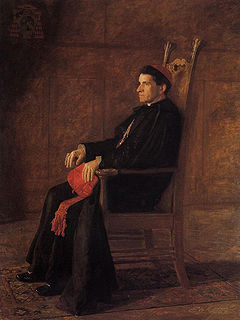
Sebastiano Martinelli was a Cardinal of the Roman Catholic Church who served as Prefect of the Congregation of Rites.

Station days were days of fasting in the early Christian Church, associated with a procession to certain prescribed churches in Rome, where the Mass and Vespers would be celebrated to mark important days of the liturgical year. Although other cities also had similar practices, and the fasting is no longer prescribed, the Roman churches associated with the various station days are still the object of pilgrimage and ritual, especially in the season of Lent.

The Church of Saint Athanasius, also known as Sant'Atanasio dei Greci, is a Greek Catholic titular church located on Via del Babuino 149, near the Spanish steps, in the rione Campo Marzio of Rome, Italy.

The Basilica of Santa Aurea is a church situated in the Ostia Antica district of Ostia, Italy. Ostia became an episcopal see as early as the 3rd century AD. The present-day church, completed in 1483, it was the seat of the suburbicarian diocese of Ostia until 1966, when Ostia became part of the diocese of Rome.

Santi Celso e Giuliano is a minor basilica church in Rome, Italy in the care of the Institute of Christ the King Sovereign Priest. It has held this status by custom and practice since ancient times. The church is located on Vicolo del Curato number 12, just off Via del Banco di Santo Spirito, the road leading to Ponte Sant'Angelo.

San Giacomo alla Lungara is a church in Rome (Italy), in the Rione Trastevere, facing on Via della Lungara. It is also called San Giacomo in Settimiano or in Settignano, due to its vicinity to Porta Settimiana, built by Septimius Severus and included by Aurelianus within the city walls.
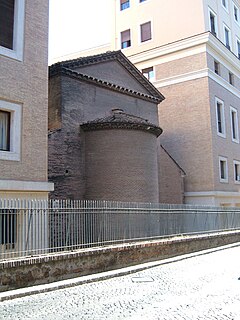
The Church of San Lorenzo in Piscibus is a 12th-century small church in the Borgo rione of Rome. It is located near Saint Peter's Square and Vatican City, but its façade is not visible from the main street, Via della Conciliazione.

Santa Maria della Concezione is a church in Rome, located on Piazza Campo Marzio in the Campo Marzio rione.

Santo Stanislao dei Polacchi, also known as San Stanislao alle Botteghe Oscure, is a Roman Catholic church in Rome, sited on Via delle Botteghe Oscure in the Sant'Angelo rione. It is the national church of Poland in Rome.
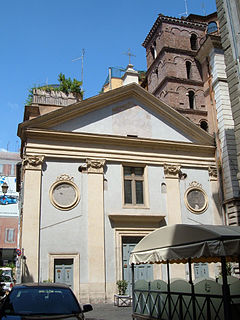
San Salvatore alle Coppelle is a church in Rome, on piazza delle Coppelle in the Sant'Eustachio district.
The church of Sant'Egidio in Borgo, ...a Borgo, or ...in Vaticano, is a Roman Catholic oratory in Vatican City dedicated to Saint Giles.
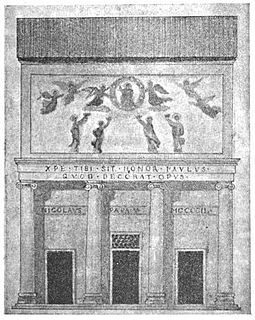
Santa Maria in Turri was an ancient church in the city of Rome, demolished in the Renaissance. It adjoined the outside atrium of the ancient Basilica of St. Peter, one of a complex of small churches or oratories that grew up around the site.

San Sebastiano de Via Papae was a small church in the Sant'Eustachio rione of Rome that was demolished in the 1590s in order to enable the construction of the church of Sant'Andrea della Valle.

Santi Sergio e Bacco al Foro Romano also called Santi Sergio e Bacco sub Capitolio was an ancient titular church in Rome, now lost. Located in the ruins of the Roman Forum, it had been one of the ancient diaconiae of the city and a collect church for one of the station days of Lent, but it was demolished in the sixteenth century.
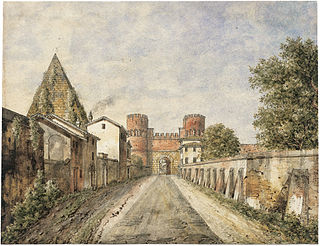
San Menna was an ancient church in Rome, formerly located along the Via Ostiensis which led to the Basilica of Saint Paul. It appears to have been destroyed at some point after the tenth century.
San Ciriaco de Camiliano was an ancient church of the city of Rome, formerly located on the present site of the Piazza del Collegio Romano near the Via del Corso. It was demolished in 1491 during construction on the church of Santa Maria in Via Lata.

Santa Maria in Monterone is a Roman Catholic church in Rome, Italy. Its suffix originates from the Sienese Monteroni family, whose patronage rebuilt the church and built a small hospice next to it for pilgrims from Siena. It is located on Via Santa Maria in Monterone in the Sant'Eustachio rione. Next to the church is a Redemptorist monastery, whose clergy manage the church.

Sant'Agata in Trastevere is one of the churches of Rome, located in the Trastevere district, at Largo San Giovanni de Matha, 91.
Coordinates: 41°54′05.8″N12°28′29.6″E / 41.901611°N 12.474889°E